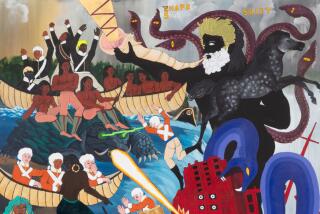Reinventing the Wheel
- Share via
He sounds more like a science-fiction writer than a car builder, with his talk of the vehicle as “an animated, robotic fashion statement” made of “carbon-based diamondoid material.”
Indeed, Nick Pugh makes his living designing special effects for the film industry, although his degree from Art Center College of Design in Pasadena is in transportation design.
The Long Beach resident, 31, says he is not a gear head enamored of nuts and bolts and pistons and plugs but, rather, an artist and futurist who sees the car as the perfect platform for turning his visions into reality.
Like most car dreamers, though, he values high performance and power.
But the futurist in him cried out for a cleaner fuel than gasoline, so he determined to build his dream car as a “21st century, high-performance hot rod” powered by compressed natural gas--a fuel whose only drawback is that it is 3.5 times bulkier than gasoline, a factor that has limited the fuel capacity and cruising range of most natural-gas-powered vehicles.
Pugh, however, has patented a chassis that incorporates large compressed natural gas storage tanks in its design. The chassis, as well as virtually everything on the low-slung, mid-engine two-seater, from race car-derived suspension system to spacey-looking aluminum wheels with coppery, cone-shaped center sections, was designed by Pugh, who has hired the mechanical and metalworking wizards at So-Cal Speed Shop in Pomona to do the actual construction. He says he has no idea how much he’ll have invested by the time the car is completed and certified to drive on the streets.
The huge 520-cubic-inch V-8 engine from General Motors’ marine division is topped by a supercharger and will draw its fuel from two large cylindrical tanks tucked into the sides of the car. Pugh hasn’t had it on a dynamometer yet to determine the horsepower but says a recent test drive showed that the lightweight car will “go like mad.”
The car has been two years in construction and nearly a decade in design--a design that is tweaked a little bit more each time Pugh steps back and takes a new look at the skeleton.
“This is an artistic pursuit,” he says. “A car should be like a shell is to a hermit crab, something you wear for fashion and security and mobility.”
He has even made it interactive--driver and passenger can rest a hand on the base of the front suspension springs and feel them expand and compress as the tires follow the bumps in the road surface. A skin made mostly of flat panels of angular aluminum covers the chassis and hides two large pressure cylinders that carry the compressed fuel. It is pierced, though, by a series of transparent plastic panels that let the occupants watch the workings of the suspension and steering system as they motor down the road.






